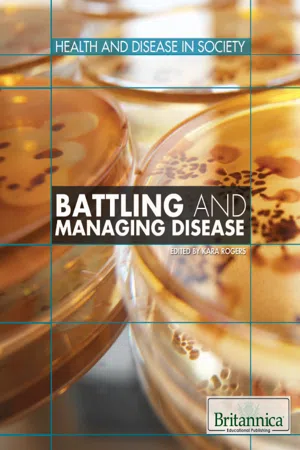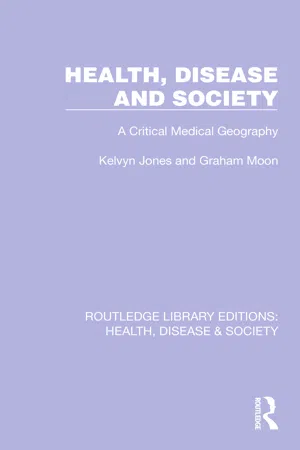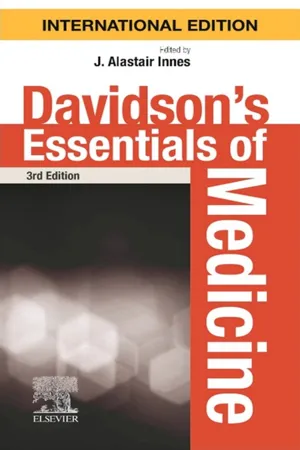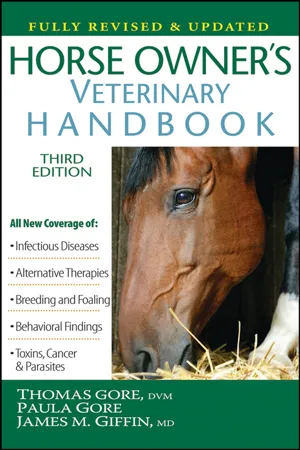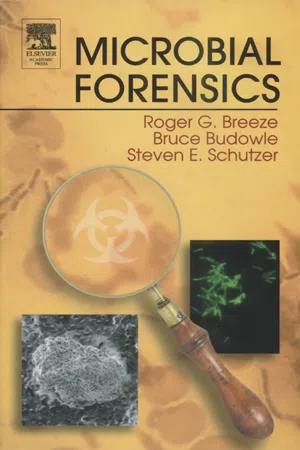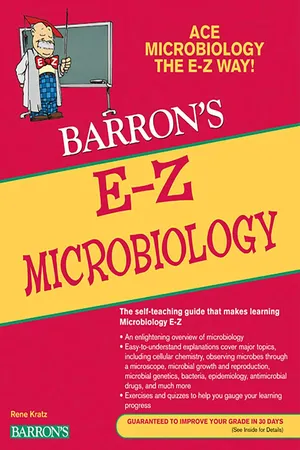Biological Sciences
Bacterial Diseases
Bacterial diseases are caused by harmful bacteria that invade the body and cause infections. These infections can range from mild to severe and can affect various parts of the body, including the skin, respiratory system, and digestive system. Treatment for bacterial diseases typically involves antibiotics and other supportive therapies.
Written by Perlego with AI-assistance
Related key terms
Related key terms
1 of 4
Related key terms
1 of 3
9 Key excerpts on "Bacterial Diseases"
- eBook - ePub
- Britannica Educational Publishing, Kara Rogers(Authors)
- 2010(Publication Date)
- Britannica Educational Publishing(Publisher)
Viral diseases cannot be treated with antimicrobial agents. This point is made because of a distressing tendency among individuals to take penicillin or another antibiotic for a common cold. Although no cure is available for most viral infections, prevention of infection through the administration of vaccines has proven valuable in reducing the incidence of certain viral diseases, including polio and measles. In addition, antiviral drugs have been developed to reduce the severity of symptoms associated with some viral infections, particularly those involving influenza or HIV.BACTERIAL DISEASESThe diseases produced by bacteria are the most common of infectious biotic diseases. They range from trivial skin infections to such devastating disorders as bubonic plague and tuberculosis. Various types of pneumonia; infections of the cerebrospinal fluid (meningitis), the liver, and the kidneys; and the sexually transmitted diseases syphilis and gonorrhea are all forms of bacterial infection.All bacteria induce disease by one of three methods: (1) the production of an exotoxin, a harmful chemical substance that is secreted or excreted by the bacterium (as in food poisoning caused by Clostridium botulinum ); (2) the elaboration of an endotoxin, a harmful chemical substance that is liberated only after disintegration of the microorganism (as in typhoid, caused by Salmonella typhi ); or (3) the induction of sensitivity within the host to antigenic properties of the bacterial organism (as in tuberculosis, after sensitization to Mycobacterium tuberculosis ).Human rickettsial diseases are caused by microorganisms that fall between viruses and bacteria in size. These minute agents are barely visible under the ordinary light microscope. Like viruses, they multiply only within the cells of susceptible hosts. They are found in nature in a variety of ticks and lice and, when transmitted to humans by the bite of one of these arthropods, usually cause acute febrile (fever-producing) illnesses, most of which are characterized by skin rashes. Rocky Mountain spotted fever, a systemic rickettsial infection, invades and kills the cells lining blood vessels and causes hemorrhage, inflammation, blood clots, and extensive tissue death. If untreated, it is fatal in about 20 to 30 percent of cases.E. COLIEscherichia coli, or simply E. coli, is a species of bacterium that normally inhabits the stomach and intestines. When - eBook - ePub
Health, Disease and Society
A Critical Medical Geography
- Kelvyn Jones, Graham Moon(Authors)
- 2022(Publication Date)
- Routledge(Publisher)
This chapter is concerned with diseases that are capable of being transmitted from someone who is infected (the host) to someone who has not yet had the disease (the susceptible); they are variously known as contagious, infectious and communicable diseases. In the industrialised countries, despite the recent threat of AIDS, they are generally of low importance; even in childhood, communicable diseases are a minor cause of suffering and morbidity and now cause less than 5 per cent of all childhood deaths in Britain. Historically, they have been of much greater importance; only forty years ago tuberculosis was the disease of civilisation, and in the economically backward countries they remain the major killers today. Communicable diseases are given a separate chapter here because of this worldwide importance (two-thirds of all human illness is attributed to such causes), and because their fundamentally different disease processes, when compared to chronic and degenerative diseases, require different modes of analysis. The discussion begins with a brief introduction to the biology of the diseases and then the different research traditions of ‘disease ecology’ and ‘diffusion’ studies are outlined and illustrated. As the discussion proceeds we move away from the biomedical model towards a social, and arguably deeper, understanding of communicable diseases.The biology of infectious diseases
Communicable diseases have a bewildering diversity and it is wise at the outset to offer a classification. It is possible to produce a classification on a number of criteria (for example, portal of entry and exit of infectious agent) but a classification based on the various types of organisms and their differing means of transmission is most appropriate for our purposes.Organisms
There are six basic groups of organisms (Open University, 1985b ).- Viruses are chains of nucleic acid surrounded by a protein coat; they cannot reproduce themselves without entering the cells of plants or animals. They produce such diseases as influenza, measles (rubella), rabies, herpes, smallpox, encephalitis, yellow fever, dengue fever and German measles.
- Bacteria are true cells but have no nucleus. One example is tetanus which secretes a toxin which is taken up by the nerve endings and disrupts the nerves to the spinal cord and the brain, thereby producing an intense muscular spasm; hence the term ‘lockjaw’. Other Bacterial Diseases include diphtheria, pneumonia, sinusitis, botulism, gonorrhoea, typhoid, cholera, whooping cough (pertussis), yaws, syphilis and dental caries.
- Fungi produce diseases such as ‘thrush’ which results in an intense itching in the vagina, and ringworm, a skin disease which is most prevalent among children.
- Protozoa are single-celled organisms which are able to change their shape and are generally bigger than bacteria. Plasmodia produce malaria, while Trypanasoma results in sleeping sickness which currently affects an estimated 40 million people.
- Insects such as ticks and mites are multicellular organisms.
- Helminths are also multicellular organisms and they often have a complicated lifecycle. Examples include hookworms, which attack the wall of the intestine and feed off blood, thereby producing anaemia in the host, and the Ascaris
- eBook - ePub
- Azhar ul Haque Sario, Azhar ul Haque Sario(Authors)
- 2023(Publication Date)
- tredition(Publisher)
Disease and immunityDiseaseA pathogen, in the simplest terms, is a tiny organism that causes disease. Think of it as an unwanted guest in your body, one that definitely wasn't invited and causes trouble once it's inside. There are various types of these disease-causing villains, each with its own unique way of disrupting our health.Firstly, we have bacteria. These are single-celled organisms, and they're quite versatile in where they can live and how they can make us sick. Some bacteria are harmless, even beneficial, but others are the culprits behind illnesses like strep throat or urinary tract infections.Then there are viruses, which are even smaller than bacteria. These tiny intruders can't survive on their own – they need to hijack our cells to multiply. Common colds and more serious diseases like COVID-19 are caused by viruses.Fungi, another type of pathogen, might make you think of mushrooms or mold, but they can also live on the human body. When they overgrow or invade deeper into the body, they can cause infections, especially in people with weakened immune systems.Lastly, there are parasites. These organisms live on or inside a host and may cause illness. They range from tiny protozoa, like those causing malaria, to larger worms that can inhabit the intestines.So, how do these pathogens make us sick? They have various strategies. Some produce toxins that harm our cells, while others directly invade and damage our tissues. Our immune system often jumps into action to fight these invaders, which can lead to symptoms like fever or inflammation.Understanding pathogens is crucial in biology and medicine. Researchers, like biology analysts, tirelessly study these organisms to develop treatments, vaccines, and better ways to prevent infections. In this ongoing battle for health, knowledge about pathogens is a powerful weapon.Transmissible diseases are akin to invisible intruders that can effortlessly leap from one individual to another. Think of them as minuscule, unseen creatures, known as pathogens. These can be viruses, similar to those causing a common cold, or bacteria, like those behind strep throat. They act like uninvited guests who sneak into our bodies often without us realizing it. - eBook - ePub
- J. Alastair Innes(Author)
- 2020(Publication Date)
- Elsevier(Publisher)
5: Infectious disease
‘Infection’ occurs when infectious agents become established in the host’s tissues, replicate, cause harm and induce a host response. If a microorganism survives and replicates on a mucosal surface without causing illness, the host is said to be ‘colonised’. If a microorganism lies dormant after invading host tissues, the infection is said to be ‘latent’. When the infectious agent, or the host response to it, is sufficient to cause illness, then the process is termed an ‘infectious disease’. Not all infections are ‘infectious’, that is, transmissible from person to person. Infectious diseases transmitted between hosts are called communicable diseases, whereas those caused by organisms that are already colonising the host are described as endogenous.Principles of infectious disease
Infectious agents are divided into the following categories:- • Viruses—RNA- or DNA-containing pathogens that rely on host cells for replication.
- • Prokaryotes: bacteria—capable of independent replication but lacking a nucleus.
- • Eukaryotes—fungi, protozoa and helminths.
- • Prions—not microorganisms but misfolded proteins without nucleic acids; cause transmissible encephalopathies (see p. 694).
The human body is colonised by large numbers of bacteria (termed the human microbiota or normal flora), which have a profound influence on human health. Some benefit the host (e.g. gut flora producing vitamins K and B12 ). In contrast, disease results when pathogenic organisms produce virulence factors that damage host cells. Primary pathogens cause disease in healthy hosts, whereas opportunistic pathogens cause disease only in the immune-compromised host.Clinical examination of patients with infectious disease
Detection of infection
A variety of methods are used:-
Direct detection of organisms:
- eBook - ePub
- Thomas Gore, Paula Gore, James M. Giffin(Authors)
- 2008(Publication Date)
- Howell Book House(Publisher)
3I NFECTIOUS D ISEASESInfectious diseases are caused by bacteria, viruses, protozoans, fungi, and rickettsia, all of which invade the body of a susceptible host and cause illness. Most infectious diseases are transmitted from one animal to another by contact with infected urine, feces, and other bodily secretions or by inhaling pathogen -laden droplets in the air. A few are sexually transmitted. Others are acquired by contact with spores or bacteria in the soil, which get into the body through the respiratory tract or a break in the skin. A number of infectious diseases are transmitted by insects and ticks; a few are blood-borne and can be transmitted by poor husbandry techniques.Although pathogens exist everywhere in the environment, only a few cause infection . Fewer still are contagious. Many infectious diseases are species-specific. For example, a dog cannot catch a disease that is specific to a horse, and vice versa. In a few instances, a disease is zoonotic , meaning it can be passed to humans from animals, or to animals from humans.Many infectious agents are able to survive for long periods outside the host animal. This knowledge is important in determining how to contain the spread of infection. For many diseases, the best way to prevent them is by vaccination and environmental management. Immunity and vaccinations are discussed at the end of this chapter.Bacterial DiseasesBacteria are single-celled microorganisms. Although some are beneficial to the body, many are noted for their ability to cause disease. Bacteria may also release exotoxins or endotoxins into the body. Exotoxins are toxic proteins produced by the bacteria and released into their environment. Endotoxins are part of the outer cell wall of bacteria and are released when the cell membranes rupture.SalmonellosisSalmonellosis is the most common cause of infectious diarrhea in the adult horse and an important cause of septicemia in foals . For a discussion of salmonella bacterial enteritis in newborns, see page 557 - eBook - ePub
- H. W. (Herbert William) Conn(Author)
- 2004(Publication Date)
- Perlego(Publisher)
This, in the merest outline, represents the relation of bacterial parasites to the human body But while this is a fair general expression of the matter, it must be recognised that different diseases differ much in their relations, and no general outline will apply to all They differ in their method of attack and in the point of attack. Not only do they produce different kinds of poisons giving rise to different symptoms of poisoning; not only do they produce different results in different animals; not only do the different pathogenic species differ much in their power to develop serious disease, but the different species are very particular as to what species of animal they attack. Some of them can live as parasites in man alone; some can live as parasites upon man and the mouse and a few other animals; some can live in various animals but not in man; some appear to be able to live in the field mouse, but not in the common mouse; some live in the horse; some in birds, but not in warm-blooded mammals; while others, again, can live almost equally well in the tissues of a long list of animals. Those which can live as parasites upon man are, of course, especially related to human disease, and are of particular interest to the physician, while those which live in animals are in a similar way of interest to veterinarians.Thus we see that parasitic bacteria show the widest variations. They differ in point of attack, in method of attack, and in the part of the body which they seize upon as a nucleus for growth. They differ in violence and in the character of the poisons they produce, as well as in their power of overcoming the resisting powers of the body. They differ at different times in their powers of producing disease. In short, they show such a large number of different methods of action that no general statements can be made which will apply universally, and no one method of guarding against them or in driving them off can be hoped to apply to any extended list of diseases.DISEASES CAUSED BY OTHER ORGANISMS THAN BACTERIA.
Although the purpose of this work is to deal primarily with the bacterial world, it would hardly be fitting to leave the subject without some reference to diseases caused by organisms which do not belong to the group of bacteria. While most of the so-called germ diseases are caused by the bacteria which we have been studying in the previous chapters, there are some whose inciting cause is to be found among organisms belonging to other groups. Some of these are plants of a higher organization than bacteria, but others are undoubtedly microscopic animals. Their life habits are somewhat different from those of bacteria, and hence the course of the diseases is commonly different. Of the diseases thus produced by microscopic animals or by higher plants, one or two are of importance enough to deserve special mention here.Malaria.—The most important of these diseases is malaria in its various forms, and known under various names—chills and fever, autumnal fever, etc. This disease, so common almost everywhere, has been studied by physicians and scientists for a long time, and many have been the causes assigned to it. At one time it was thought to be the result of the growth of a bacterium, and a distinct bacillus was described as producing it. It has finally been shown, however, to be caused by a microscopic organism belonging to the group of unicellular animals, and somewhat closely related to the well-known amoeba. This organism is shown in Fig. 34. The whole history of the malarial organism is not yet known. The following statements comprise the most important facts known in regard to it, and its relation to the disease in man. - eBook - ePub
- Bruce Budowle, Steven E. Schutzer, Roger G. Breeze(Authors)
- 2005(Publication Date)
- Academic Press(Publisher)
CHAPTER 2Infectious Diseases: Not Just a Health Matter Anymore
ROGER G. BREEZE, Centaur Science Group, Washington, DC, USAPublisher Summary
This chapter focuses on the development of preparations for uncommon infectious diseases. Biological agents developed as weapons pose different threats than naturally occurring diseases. Nation states, organized groups, and individuals are aware about the irrevocable damage caused by such diseases. The intelligence community and the Departments of Homeland Security, Justice, and State have joined the traditional agencies—Agriculture, Defense, and Health and Human Services (HHS)—as significant players in studies of infectious diseases of humans, animals, and plants. Biological warfare—the use of disease-spreading microorganisms, toxins, and pests against enemy armed forces or civilians—as historically intended or conducted by nation states for military purposes, generally focused on infectious but noncontagious agents. The goal of health professionals is to identify the properties of the virus and host that can be useful for diagnosis, treatment, and prevention. The biological community needs specific new tools to achieve a balance between adequately monitoring certain biological agents and toxins and not obstructing legitimate research and development involving those agents and toxins. Advisable steps in this direction are: a reappraisal of the biological agents, a proper Bio-security Risk Assessment starting with a definition of the facility’s biological inventory and evaluating the consequences of its loss: a step that enables the pathogens to be prioritized based on those consequences. The volume elaborates upon the needs of Federal Bureau of Investigation (FBI) specifying the usage of biological information with other evidence to investigate and correctly attribute and prosecute criminal activity, and the standards that courts will demand for the scientific evidence. - eBook - ePub
- Rene Kratz(Author)
- 2011(Publication Date)
- Barrons Educational Services(Publisher)
3. Pathology is the study of disease. Pathogenesis is the development of the disease in the body. A pathogen is an organism capable of causing disease. Opportunistic pathogens cause disease in weakened hosts. An infection is the colonization of the body by a microbe. Disease is an abnormal change in the state of health. Normal microbiota are the microorganisms that normally live in and on the body without causing disease.4. Some organisms can become pathogenic when the host is weakened. Hosts may be weakened by other infections, burns, surgery, or poor general health owing to poor nutrition or age.5. The normal microbiota takes up space and nutrients on the body, preventing transient microbiota from colonizing. Some members of the normal microbiota can produce compounds that inhibit growth of bacteria (bacteriocins) or may change the pH so that other organisms cannot grow. They may also benefit the body by synthesizing vitamins.6. Symptoms are the subjective things a patient feels. Signs are objective things that can be measured. Syndrome is the collection of signs and symptoms associated with a particular disease. Communicable diseases can be spread from one person to another. Noncommunicable diseases cannot be spread. Contagious diseases are spread easily. Acute diseases develop rapidly and are of short duration. Chronic diseases develop more slowly and last a long time. Subacute diseases are of intermediate duration between acute and chronic. Latent diseases have periods of inactivity. Local infections are limited to one area of the body. Focal infections begin in one area but then spread through the blood or lymph. Systemic infections spread throughout the body through the blood or lymph. Bacteremia indicates the presence of bacteria in the blood. Toxemia indicates the presence of toxins in the blood. Viremia indicates the presence of viruses in the blood. Septicemia indicates bacteria multiplying in the blood. A primary infection is when the initial infection causes the disease. A secondary infection is when a disease is caused by an opportunistic pathogen after the host is weakened by a prior infection. A subclinical infection has no detectable signs.7. - eBook - ePub
A New History of Vaccines for Infectious Diseases
Immunization - Chance and Necessity
- Anthony R. Rees(Author)
- 2022(Publication Date)
- Academic Press(Publisher)
Chapter 1: Infectious diseases: a historical documentary
Abstract
A brief history of infectious pathogens. The origins of bacteria and their capacity to develop antibiotic resistance, the nature of viruses, and the role animals play in the passage of disease to humans. The aims of this chapter were to draw attention to the importance of vaccines in controlling epidemics and pandemics, the historical impact of disease on susceptible populations in the absence of therapeutic intervention, the development of systematic reporting of infections and disease, and the early origins and basic concepts of what became the discipline of epidemiology.Keywords
Bacteria; Epidemics and pandemics; Epidemiology; Infectious disease; Population health; Vaccines; VirusesThe infectious diseases that have afflicted the human race for the past 200,000 years are largely a result of microorganisms and viruses that have adapted their survival to the human host. Where we know about them these diseases have been at best uncomfortable and at worst devastating. The outstanding question for the 21st century is whether the new infectious agents we are encountering today can be neutralized by current medical advances and whether cures for those we have yet to encounter can be anticipated, or at least fast-track solutions identified. The most recent Ebola and SARS-CoV-2 outbreaks do not bode well for the latter.Epidemics and pandemics (epidemics with global reach) are not new. The Great (bubonic) Plague in its second pandemic is believed to have started in China arriving in Europe in the late 14th century. Over the next three centuries, culminating in a repeat outbreak in London in 1665, bubonic plague, a bacterial (Yersinia pestis ) infection transmitted by fleas (rat or even perhaps human1) that carry the bacteria and puncture the skin leading to inflamed lymph glands or “bubos,” and the much more dangerous pneumonic plague, a bacterial infection of the lungs causing pneumonia and transmitted by droplets of infected sputum, together have been estimated to have wiped out up to 60% of the European population.2If you had escaped infection by plague, smallpox was waiting in the wings with a no less devastating effect and an equally high mortality rate but we shall return to the smallpox story a little later. During and after the First World War, 1918–1919, the influenza virus strain responsible for the Spanish ‘flu,3known as the 1918 strain4
Index pages curate the most relevant extracts from our library of academic textbooks. They’ve been created using an in-house natural language model (NLM), each adding context and meaning to key research topics.
Explore more topic indexes
Explore more topic indexes
1 of 6
Explore more topic indexes
1 of 4
